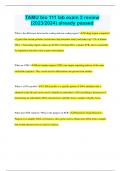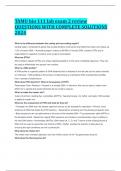Study guides, Class notes & Summaries
Looking for the best study guides, study notes and summaries about ? On this page you'll find 41 study documents about .
All 41 results
Sort by
 Popular
Popular
-
TAMU bio 111 lab exam 2 review (2023/2024) already passed
- Exam (elaborations) • 14 pages • 2023
- Available in package deal
-
- $9.99
- 2x sold
- + learn more
TAMU bio 111 lab exam 2 review (2023/2024) already passed What is the difference between the coding and non-coding region? Coding region: comprised of genes that encode proteins (instructions that determine traits) and makes up 1-2% of human DNA. • Noncoding region: makes up 98-99% of human DNA, contains STRs and is responsible for regulatory functions such as gene transcription. What are STRs? Short-tandem repeats (STRs) are unique repeating patterns of the same nucleotide sequence. They can...
QUESTIONS AND ANSWERS
QUESTIONS AND ANSWERS

-
TAMU bio 111 lab exam 2 review 2024/2025 Questions And Answers 100% Solved | 100% Pass
- Exam (elaborations) • 8 pages • 2024
-
- $8.49
- + learn more
TAMU bio 111 lab exam 2 review 2024/2025 Questions And Answers 100% Solved | 100% Pass What is the difference between the coding and non-coding region? - Coding region: comprised of genes that encode proteins (instructions that determine traits) and makes up 1-2% of human DNA. • Noncoding region: makes up 98-99% of human DNA, contains STRs and is responsible for regulatory functions such as gene transcription. What are STRs? - Short-tandem repeats (STRs) are unique repeating pattern...

-
Tamu Bio 111 Exam 1 Study Guide (CH 1-5) Questions And Answers 100% Solved | Rated A+
- Exam (elaborations) • 11 pages • 2024
-
- $11.49
- + learn more
Tamu Bio 111 Exam 1 Study Guide (CH 1-5) Questions And Answers 100% Solved | Rated A+ EUKARYOTIC CELL - Cell containing a nucleus and membrane-enclosed organelles PROKARYOTIC CELL - Cell that lacks a nucleus or other membrane-enclosed organelles LEVELS OF BIOLOGICAL ORGANIZATION - Atoms, Molecules, Cells, Organelles, Tissues BIOLOGICAL DOMAINS - Bacteria, Archaea, Eukarya REDUCTIONIST APPROACH - Biologically break everything down into the simplest possible components SYSTEMS BIOLOGY AP...

-
TAMU BIO 111 Exam 1 2024/2025 Questions And Answers 100% Solved | 100% Pass
- Exam (elaborations) • 10 pages • 2024
-
- $10.99
- + learn more
TAMU BIO 111 Exam 1 2024/2025 Questions And Answers 100% Solved | 100% Pass Natural Science - · the field of science related to the physical world and its phenomena and processes. Physical Science - astronomy, chemistry, physics Life Science - Biology Basic Science - Science done to gain knowledge, regardless of the application. "knowledge for knowledge" Applied Science - Science applied to the real world. The problem is defined by the researcher Inductive Reasoning - Describes th...

-
TAMU BIO 111 Exam 1 2024/2025 Questions And Answers 100% Solved | 100% Pass
- Exam (elaborations) • 10 pages • 2024
-
- $8.99
- + learn more
Natural Science - · the field of science related to the physical world and its phenomena and processes. Physical Science - astronomy, chemistry, physics Life Science - Biology Basic Science - Science done to gain knowledge, regardless of the application. "knowledge for knowledge" Applied Science - Science applied to the real world. The problem is defined by the researcher Inductive Reasoning - Describes through careful observation and analysis of data. Scientist derive generalizations...

-
Tamu Bio 111 Exam 1 Study Guide (CH 1-5) Questions And Answers 100% Solved | Rated A+
- Exam (elaborations) • 11 pages • 2024
-
- $8.99
- + learn more
EUKARYOTIC CELL - Cell containing a nucleus and membrane-enclosed organelles PROKARYOTIC CELL - Cell that lacks a nucleus or other membrane-enclosed organelles LEVELS OF BIOLOGICAL ORGANIZATION - Atoms, Molecules, Cells, Organelles, Tissues BIOLOGICAL DOMAINS - Bacteria, Archaea, Eukarya REDUCTIONIST APPROACH - Biologically break everything down into the simplest possible components SYSTEMS BIOLOGY APPROACH - Tie small parts back together into a whole. EVOLUTION NEEDS THREE THINGS TO WORK...

-
TAMU BIO 111 Exam 1 2024/2025 Questions And Answers 100% Solved | 100% Pass
- Exam (elaborations) • 10 pages • 2024
-
- $8.49
- + learn more
Natural Science - · the field of science related to the physical world and its phenomena and processes. Physical Science - astronomy, chemistry, physics Life Science - Biology Basic Science - Science done to gain knowledge, regardless of the application. "knowledge for knowledge" Applied Science - Science applied to the real world. The problem is defined by the researcher Inductive Reasoning - Describes through careful observation and analysis of data. Scientist derive generalizations...

-
TAMU bio 111 lab exam 2 review (2023/2024) already passed Geaded A+
- Exam (elaborations) • 18 pages • 2024
-
- $12.99
- + learn more
TAMU bio 111 lab exam 2 review (2023/2024) already passed What is the difference between the coding and non-coding region? Coding region: comprised of genes that encode proteins (instructions that determine traits) and makes up 1-2% of human DNA. • Noncoding region: makes up 98-99% of human DNA, contains STRs and is responsible for regulatory functions such as gene transcription. What are STRs? Short-tandem repeats (STRs) are unique repeating patterns of the same nucleotide sequence. They can ...
TEXAS A&M BIOLOGY 111 PRACTICAL EXAM PREP EXAM QUESTIONS AND ANSWERS 20-24






